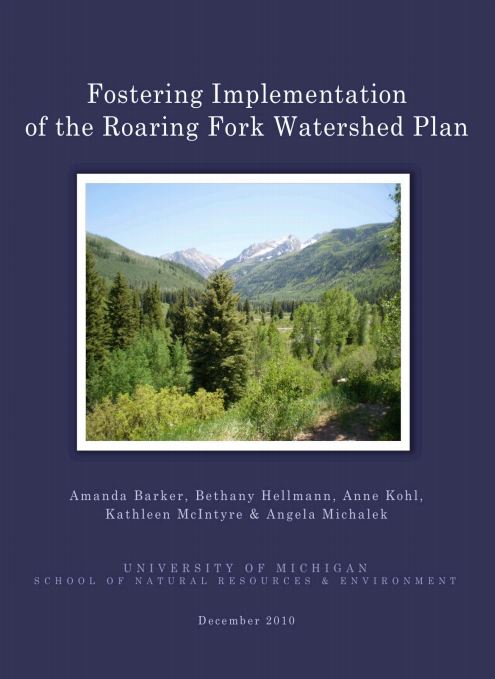ABSTRACT
Regional planning efforts for natural resource management are often complicated by the sheer number and range of partners involved. Collaboration among these stakeholders has become of increasing importance over the past few decades. The Roaring Fork Watershed Collaborative (RFWC) evolved as a regional planning effort across three counties and five municipalities on the Western Slope of Colorado. The RFWC – Water Committee is a diverse set of stakeholders working to integrate the environmental, social and economic values of the region into a Watershed Plan. An increasing amount of water-intensive energy extraction, population growth and uncertainties surrounding climate change will likely place additional strain on already overallocated water resources in the Roaring Fork Watershed. The purpose of this report is to inform the RFWC – Water Committee about how other collaborative watershed partnerships have formed and organized. This research explores the history, organizational structure, challenges, activities and facilitating factors of twenty ecosystem management partnerships throughout the American West. The cases studied highlight the importance of initial activities such as joint fact finding and information sharing. These twenty partnerships also point to the benefits and challenges associated with involving a wide range of partners. Organizations tend to formalize their commitments to provide a sense of legitimacy, instill confidence in the collaborative process, and guide their actions. The RFWC – Water Committee was also interested in learning more about public awareness campaigns and other education initiatives. Interestingly, most of the twenty partnerships emphasized the integral role of public education and awareness in protecting, enhancing and restoring the watershed. In addition, the report also provides ten case studies of public awareness initiatives. Many of these initiatives underscore ways research can be used to design effective public awareness campaigns. Finally, the lessons from these twenty partnerships and ten public awareness initiatives are used to provide a set of recommendations that the RFWC – Water Committee might consider. While the report has been customized to the RFWC – Water Committee, many of the lessons and themes should be of interest to other nascent watershed partnerships.
2010 Fostering Implementation of the Roaring Fork Watershed Plan

ACKNOWLEDGMENTS
We would like to acknowledge the following individuals and organizations for their expert knowledge and opinions, heartfelt support, and recommendations.
First and foremost, we thank Dr. Julia Wondolleck, our project’s faculty advisor, mentor and friend. She helped us through many trials and tribulations during this project’s completion. Julia was always available with constructive comments and words of wisdom as we struggled to define the parameters of this project and always with gentle reminders to “keep the interests of the Roaring Fork Watershed Collaborative- Water Committee in mind.”
We thank Sharon Clarke and Tim O’Keefe with the Roaring Fork Conservancy (RFC) and Mark Fuller with Ruedi Water and Power Authority (RWAPA), who helped make this project a reality. Through emails, conference calls and two trips to Basalt, Colorado, RFC and RWAPA helped us to see what Roaring Fork Watershed Collaborative- Water Committee is all about from an “insider’s perspective.” We would like to thank Rose Ann Sullivan, the SNRE alumnus who proposed this topic as a master’s project and initiated the partnership between UM School of Natural Resources and Environment and the Roaring Fork Watershed Collaborative- Water Committee.
We thank our contacts from the 20 collaborative natural resource management partnerships and 10 public outreach organizations that we researched over the past year. Without your generous and thoughtful input to our questions (and follow-up questions), we would not have been able to develop the useful case studies in the following pages.
Lastly, we thank all of our families, friends and colleagues for their continued support throughout the completion of this project. Your emotional support and enduring encouragement have helped us survive this past year of writing, revising, editing and more writing. We could not have accomplished this project without you!